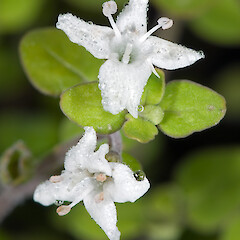Mentha cunninghamii
Common name
New Zealand mint, hīoi
Synonyms
Mentha consimilis Colenso
Family
Lamiaceae
Flora category
Vascular – Native
Endemic taxon
Yes
Endemic genus
No
Endemic family
No
Structural class
Herbs - Dicotyledons other than Composites
NVS code
The National Vegetation Survey (NVS) Databank is a physical archive and electronic databank containing records of over 94,000 vegetation survey plots - including data from over 19,000 permanent plots. NVS maintains a standard set of species code abbreviations that correspond to standard scientific plant names from the Ngä Tipu o Aotearoa - New Zealand Plants database.
MENCUN
Chromosome number
2n = 72
Current conservation status
The conservation status of all known New Zealand vascular plant taxa at the rank of species and below were reassessed in 2017 using the New Zealand Threat Classification System (NZTCS) – more information about this can be found on the NZTCS website. This report includes a statistical summary and brief notes on changes since 2012 and replaces all previous NZTCS lists for vascular plants.
Please note, threat classifications are often suggested by authors when publications fall between NZTCS assessment periods – an interim threat classification status has not been assessed by the NZTCS panel.
- Conservation status of New Zealand indigenous vascular plants, 2017 . 2018. Peter J. de Lange, Jeremy R. Rolfe, John W. Barkla, Shannel P. Courtney, Paul D. Champion, Leon R. Perrie, Sarah M. Beadel, Kerry A. Ford, Ilse Breitwieser, Ines Schönberger, Rowan Hindmarsh-Walls, Peter B. Heenan and Kate Ladley. Department of Conservation. Source: NZTCS and licensed by DOC for reuse under the Creative Commons Attribution 4.0 International licence.
2017 | At Risk – Declining | Qualifiers: PD
Previous conservation statuses
2012 | At Risk – Declining | Qualifiers: DP
2009 | Not Threatened
2004 | Not Threatened
Distribution
Endemic. New Zealand: North Island, South Island, Chatham Islands and Stewart Island/Rakiura.
Habitat
Coastal to alpine. Sparse component of grassland and other open places such as cliffs, river banks, lake sides, grey scrub, occasionally in swampy ground.
Wetland plant indicator status rating
Information derived from the revised national wetland plant list prepared to assist councils in delineating and monitoring wetlands (Clarkson et al., 2021 Manaaki Whenua – Landcare Research Contract Report LC3975 for Hawke’s Bay Regional Council). The national plant list categorises plants by the extent to which they are found in wetlands and not ‘drylands’. The indicator status ratings are OBL (obligate wetland), FACW (facultative wetland), FAC (facultative), FACU (facultative upland), and UPL (obligate upland). If you have suggestions for the Wetland Indicator Status Rating, please contact: [Enable JavaScript to view protected content]
FAC: Facultative
Commonly occurs as either a hydrophyte or non-hydrophyte (non-wetlands).
Detailed description
Gynodioecious, rhizomatous to ± stoloniferous, perennial forming loose patches up to 300 mm across. Stems sparse to numerous, very slender, purple to purple-red, puberulent (especially on angles), initially ± creeping, subscandent or ascending at tips, usually much branched. Leaves bright green to yellow-green, sessile or with short hairy petioles 2–4 mm long; lamina 2–15 × 2–15 mm, broad-ovate to suborbicular, smooth, entire or shallowly crenate, gland-dotted, mostly glabrous except for nerves on lower surface; base broad-cuneate or truncate; apex rounded. Flowers axillary, fragrant, solitary or in clusters of 1–3; pedicels prominent, puberulent. Calyx 3–4 mm long, narrow-campanulate to campanulate, villous, gland-dotted; teeth narrow-triangular, ciliate, much < tube, acute. Corolla c. 6 mm long, white, glabrous; tube not exserted; lobes spreading, subequal; uppermost lobe ± 2-fid. Stamens scarcely exserted. Nutlets 1.0–1.3 mm long, ± broad-ellipsoid, slightly angled, smooth.
Similar taxa
Quite unlike any of the adventive Mentha species in NZ. When examining closely a sward of native turf-forming species, the presence of M. cunninghamii is often detected by its mint odour.
Flowering
October–April
Flower colours
White
Fruiting
October–June
Propagation technique
Easily grown from rooted pieces and fresh seed. Needs full sun to flourish. Once established tolerant of a range of conditions. An attractive pot plant.
Threats
Habitat degradation by livestock, irrigation, drainage; weed competition.
Etymology
mentha: Mint
cunninghamii: Named after Allan Cunningham (1791–1839) who was an English botanist and explorer, primarily known for his travels to Australia (New South Wales) and New Zealand to collect plants. Author of Florae Insularum Novae Zelandiae Precursor, 1837–40 (Introduction to the flora of New Zealand).
Attribution
Fact sheet prepared by P.J. de Lange (1 June 2013).
NZPCN Fact Sheet citation
Please cite as: de Lange, P.J. (Year at time of access): Mentha cunninghamii Fact Sheet (content continuously updated). New Zealand Plant Conservation Network. https://www.nzpcn.org.nz/flora/species/mentha-cunninghamii/ (Date website was queried)










